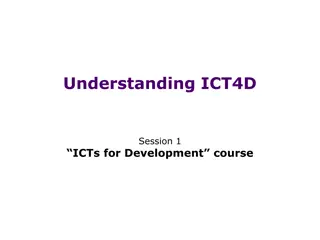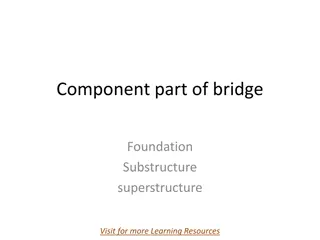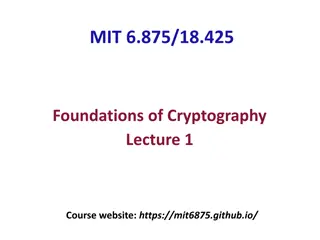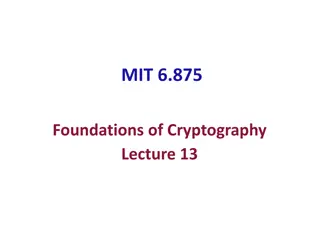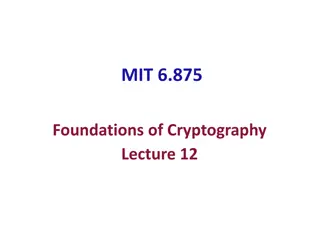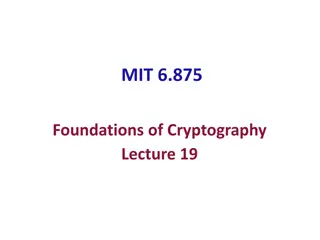Foundations of ICT4D
Delve into the technological foundations of ICT4D by examining the ICT value chain, data quality, ICT4D stakeholder roles, global stakeholders, and domains of ICT4D policy. Understand the impact of ICT in development and the diverse range of stakeholders involved in shaping ICT4D initiatives. Explore how technology, data, software, hardware, and infrastructure play crucial roles in driving ICT4D outcomes and sustainability.
Download Presentation

Please find below an Image/Link to download the presentation.
The content on the website is provided AS IS for your information and personal use only. It may not be sold, licensed, or shared on other websites without obtaining consent from the author. Download presentation by click this link. If you encounter any issues during the download, it is possible that the publisher has removed the file from their server.
E N D
Presentation Transcript
Foundations of ICT4D Session 2 ICTs for Development course
The ICT4D value chain Exogenous factors Enablers Intermediates/ deliverables -Locations (e.g. telecentres) -ICTs (e.g. PC, mobile, tablet) -Software applications Development impacts -Public goals (e.g. SDGs) - Other impacts (intended and unintended) Precursors -Data systems -Legal -Institutional -Human -Technological -Leadership & vision - Drivers/deman d Inputs Outputs -New communication patterns -New information and decisions -New actions and transactions Outcomes -Financial and other quantitative benefits -Qualitative benefits -Disbenefits -Data -Money -Labour and knowledge -Technology -Values and motivations -Political support -Goals and objectives Implementatio n Strategy Adoption Use Sustainability Scalability Constraints IMPACT UPTAKE READINESS AVAILABILITY Richard Heeks, GDI, University of Manchester, UK Adapted from Heeks 2014b
Technological foundations of ICT4D ICT user Communication & processing Data Software Hardware Infrastructure Richard Heeks, GDI, University of Manchester, UK
Data quality: OCARA Openness Completeness Data Accuracy Relevance Appropriateness of presentation Richard Heeks, GDI, University of Manchester, UK
Category Ladder of ICT4D roles Role Innovator Digital producer C Producer Enabler A Creator Active user Digital consumer Passive consumer Intermediated consumer B Indirect Digital non-user Delinked D Richard Heeks, GDI, University of Manchester, UK Image sources: www.iwmi.cgiar.org/2013/09/who-can-you-call/; www.itnewsafrica.com/2013/04/huawei-sa-khulisani-unite-in-ict-training-project/; www.indianneurosurgery.com/; https://ictec.wordpress.com/category/itu/
Global ICT4D stakeholders UNGIS ITU World Bank WSIS action lines UNCTAD UNESCO UNDP FAO UNDESA WHO Other UNGIS member agencies Richard Heeks, GDI, University of Manchester, UK
ICT4D stakeholders Government (public sector) Development agencies Hubs/labs/clu sters Partnerships ICT4D Networks Hybrid organisations Private sector NGOs Richard Heeks, GDI, University of Manchester, UK
Domains of ICT4D policy ICT4D impact Digital harm ICT consumption ICT production ICT4D production and use Human capabilities infrastructure ICT4D infrastructure Data Financial infrastructure infrastructure Technological infrastructure Legal & institutional infrastructure Richard Heeks, GDI, University of Manchester, UK
Social dimensions of the digital divide Income What are the digital divides within a Gender country: who are the groups who have Education more access to ICTs and who are the Age Ethnicity groups who have less access to ICTs? Disability Geography Richard Heeks, GDI, University of Manchester, UK
Value chain dimensions of the digital divide Adoption (ownership) Availability Accessibility Application Richard Heeks, GDI, University of Manchester, UK
Digital divide vs. digital continuum Digital divide model Haves Have nots Digital Haves Have lesses Have nots continuum model Digital provide Richard Heeks, GDI, University of Manchester, UK
The ICT4D value chain Exogenous factors Enablers Intermediates/d eliverables -Locations (e.g. telecentres) -ICTs (e.g. PC, mobile, tablet) -Software applications Development impacts -Public goals (e.g. SDGs) - Other impacts (intended and unintended) Precursors -Data systems -Legal -Institutional -Human -Technological -Leadership & vision - Drivers/demand Inputs Outputs Outcomes -Financial and other quantitative benefits -Qualitative benefits -Disbenefits -Data -Money -Labour and knowledge -Technology -Values and Motivations -Political support -Goals and objectives -New communication patterns -New information and decisions -New actions and transactions Strategy Implementation Adoption Use Sustainability Scalability Constraints IMPACT UPTAKE READINESS AVAILABILITY Richard Heeks, GDI, University of Manchester, UK Adapted from Heeks 2014b



